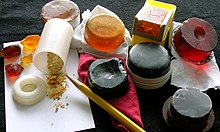Abietic acid dermatitis
| Abietic acid dermatitis | |
|---|---|
 | |
| Various types of rosin for violins, violas and cellos | |
| Specialty | Dermatology |
Abietic acid dermatitisis acontact dermatitisoften seen in association withmusical instruments.[1]
Causes
[edit]The main cause is atype-I hypersensitivityreaction to products containingabietic acid,such as therosin/colophony, which is commonly used as afriction-increasing agent. Players ofbowed string instruments(violin,viola,cello,double bass) rub cakes or blocks of rosin on theirbowso it can grip the strings.Balletandflamencodancers sometimes rub their shoes in powdered rosin to reduce slippage before going on stage.Gymnasts,baseballpitchersandten pin bowlersuse rosin to improve grip. Common locations of thiscontact dermatitisarehands,faceandneck.[2]: 1374
It has also occurred as a result ofdehydroabietic acidin an over-the-counter hydrocolloid dressing.[3]
Diagnosis
[edit]Differential diagnosis
[edit]
Cutaneous disorders in musicians includefrictional injury( "fiddler'sneck"),hyperhidrosis,acne mechanicaandvascularcompromise. Other agents of irritant and allergic contact dermatitis may berosewood,Makassar ebony,cocobolowood,African blackwood,nickel,reed,propolis(bee glue),chromiumandparaphenylenediamine.Patch testingcan be performed for identification of the cause.
Treatment
[edit]Treatment may includecorticoids,astringents,andkeratolytics.Dermatosestend to be recurrent unless the use or contact can be avoided. Discontinuation of the instrument is curative in almost all cases, but usually impractical.
See also
[edit]References
[edit]- ^Bolognia JL, Schaffer JV, Cerroni L (2017).Dermatology E-Book.Elsevier Health Sciences.ISBN978-0-7020-6342-8.Retrieved17 November2017.
- ^Rapini RP, Bolognia JL, Jorizzo JL (2007).Dermatology: 2-Volume Set.St. Louis: Mosby.ISBN978-1-4160-2999-1.
- ^Omura R, Sowa-Osako J, Tateishi C, Okazaki A, Fukai K, Kawakami T, et al. (May 2020). "Allergic contact dermatitis to abietic acid derivatives in an over-the-counter hydrocolloid dressing".Contact Dermatitis.82(5): 309–310.doi:10.1111/cod.13461.PMID31891190.S2CID209518502.
